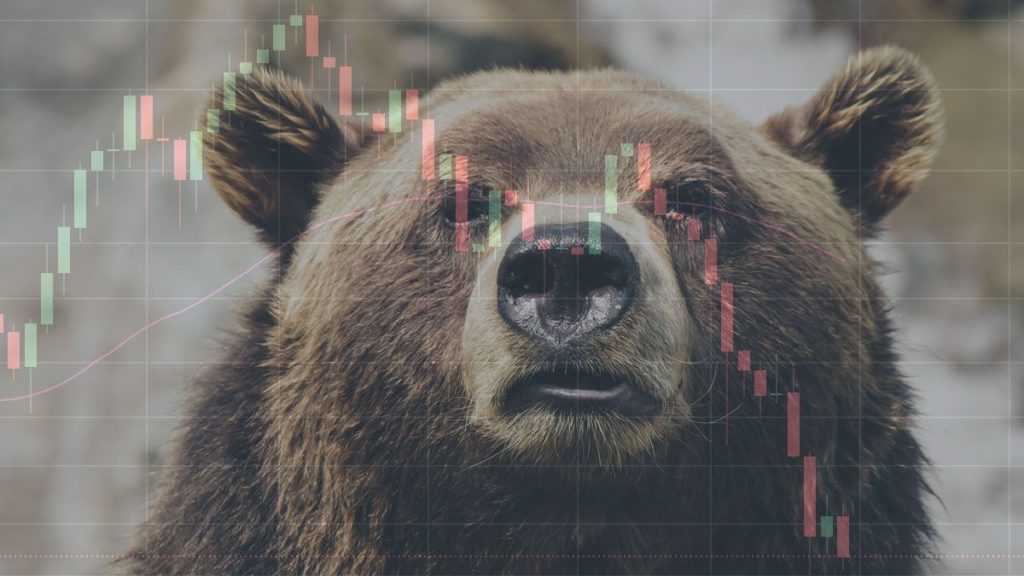Bear markets are defined by economists as a widespread drop in price by at least 20% after it has been going on for more than two months.
There seems to be no sense in investing in a bear market. You make an investment of $1,000. One day, it might be worth $998.50, and another day it might be worth $952. In about a week, it will be worth $942. It seems like the best way to lose money if you invest during a bear market is to do so.
A losing investor will rush to sell off his or her assets in order to gain some quick profit. This will push prices even lower and will prolong the severity and duration of the bear market.
The majority of investment experts claim it’s best to adopt trading strategies that minimize losses and take advantage of opportunities that only become available during bear markets.

What is a Bear Market?
In the simplest terms, a bear market describes a prolonged drop in asset prices, which in turn results in your portfolio losing value. An asset with a declining supply is more likely to receive a price drop than an asset with a rising demand due to the fact that, in a bear market, investors tend to give up on losing assets that are in their portfolio for fear of a further drop.
A bull market is the exact opposite of a bear market in a number of ways. Bull markets exist when the price of a particular asset or asset class rises for an extended amount of time, which then results in a spike in the value of your portfolio.
An uptick in market prices begins when investors are confident that prices will continue to increase over a prolonged period of time and that the uptrend will continue as well. They are anticipating the bull market and start buying and holding the assets that they believe will benefit the most from it before it actually begins.
In other words, during a bull market, a great number of investors are willing to buy while a small number of investors are eager to sell. This leads to the demand exceeding the supply, and therefore the price of the stock increases. This becomes a self-fulfilling prophecy for bullish market conditions when investors predict bullish market conditions.
Bear markets, on the other hand, begin when investors become losing confidence and start believing that prices are going to keep falling.

What causes a Bear Market?
There are times when the economy’s recession is preceded by or followed by a bear market. A number of crucial indicators such as hiring, wage growth, inflation, and interest rates are closely watched by investors to determine whether the economy is in good shape.
Several of these symptoms differed in the COVID-19 pandemic, and the large number of economic restrictions caused by closings, unemployment claims, and social distancing measures indicated that the economy was in danger.
In the event that an economy declines, investors will predict that firm profits will decline substantially. Thus, as a result, they decide to sell their stock, resulting in a decrease in the market prices and a decline in the stock market. We can expect more joblessness in the future and more challenging economic conditions if we suffer a bear market.
How long does a Bear Market last?
Generally speaking, the bear market consists of four distinct phases, the first being characterized by high prices. The second period is marked by investors accumulating profits and exiting the market.

A second phase is marked by a slowdown in asset prices, a decrease in trading activity, a decline in business earnings, and a deterioration of previously optimistic economic indicators. It is common for investors to experience fear, also known as capitulation, as the mood starts to deteriorate.
In the third stage, the market is entered by speculators, and prices and trade volumes are increased. Although Bitcoin’s price fell slowly in the fourth and final stage, it continued to fall. Eventually, we see bear markets transition into bull markets as lower prices and more optimistic news re-attract investors.
In their short existence, cryptocurrency has been subjected to multiple cycles of scorching-hot summers, followed by long, frigid winters, and the price of cryptocurrencies is no exception. As of early last year, the last downturn lasted for a period of about two and a half years.
“The next two years are going to be really rough,” says Avichal Garg, a managing partner at Electrical Capital, a crypto investment fund with more than $1 billion in assets. His fundamental views on the industry’s promise haven’t changed.
“New software developers are coming in, and we’re seeing more and more high-quality founders. We see Web2 executives from Facebook and Google coming in at a faster clip,” he says. But one big factor has backers particularly nervous: “It’s the first time that crypto and Web3 has existed in a macroeconomic bear-market environment, where there’s potentially a recession happening next year.”
How should I Invest During a Bear Market?

As a general rule, the wash-sale rule prohibits people from selling an investment for a loss and then quickly repurchasing it once the loss has been recovered. However, the crypto market is a different story. A cryptocurrency investor–whether it be a trader or a retail investor–may have lost some money on a crypto position, so there is a unique opportunity to recover these unrealized losses.
Tiered Purchases To Average Price
There is a strategy that is known as dollar-cost averaging or tiered purchases to the average price of a stock that lets investors weather bear markets. It is a method of making small regular purchases on a weekly or monthly basis that allows them to weather bear markets. It allows them to continue building a crypto portfolio without making a large purchase that they may later lose a substantial amount of money if they are not successful.
With cost averaging, price volatility is smoothed out by averaging the costs. The idea is to build a portfolio gradually according to a time-based average price so that there is no risk of buying at an exorbitantly high or low price. Consequently, even if you experience minimal risks, the value of your investment will rise as the market recovers.
If you use cost averaging, you will not have to worry about timing the market and predict whether prices will drop further or rise after a decline.

Calculate Possible Entry Risks and your Risk Tolerance
For any given investment, the risk-to-reward ratio is defined as the relationship between the potential risks of the investment and the potential gains. The RR ratio is used for the purpose of assessing the difference between entry points and stop losses, as well as taking profit orders based on the RR ratio. A fundamental goal of all trading strategies is to achieve maximum reward with the lowest risk at the same time.
It is possible to identify risk by taking into account the price gap between the closing price and the stop-loss order. In opposition to this, profit targets are generally a price level where a trader should get out of a market with considerable profit once the price reaches it. As an example of how traders can identify the takes profit level, they can measure how far their entry point is from their target profit level.
Diversify but Always in Solid Projects
There are certain segments of the market that get hit harder than others in every bear market. Diversifying your portfolio is a great way to minimize losses while taking advantage of gains in thriving markets, according to experts.
If you’re investing in the crypto world, it may mean spreading your investments across large-cap market leaders, emerging new cryptos that are growing quickly, decentralized currencies and tokens, as well as crypto assets associated with the NFT market and stablecoins.
Diversification is the process of distributing your portfolio’s risk across different segments so that when a segment loses value, the other segments will have a lesser impact.

Don’t Panic; think Long Term
It is understandable that when prices plummet, investors are tempted to cash out on their investments. It is true, however, that if you are forced to sell your crypto at a loss, then a statistical, on-paper market downturn becomes a real-life, tangible, substantial loss on your own.
A financial advisor with experience says that it is best to take a deep breath and stick with the market. It is always possible to achieve long-term gains in long-term bear markets, and investors are rewarded with gains in the long run who have the patience to ride out the storm. It is possible that some cryptos will not survive a market downturn, but if your portfolio is well-diversified and you are able to handle any bumps in the road, staying in the market can provide you with the opportunity to make money when it arises.
Study Each Investment Personally
Even though the market has been experiencing a severe downturn, some cryptos have been able to maintain their value. This is often the case with coins and tokens that are related to a market segment that is experiencing significant growth at the moment.
In spite of the market slump and the decline in the value of cryptos, industries such as video game development and online gambling have performed well due to their use in these industries. If you have specific knowledge of the operations of the specific market segment you wish to participate in, then the coins associated with DeFi, fan-based NFT marketplaces, cross-chain communications, and other applications are worth evaluating.
There is also value in analyzing the performance of specific cryptos during previous market swings because it will provide further insight. During bear markets, some cryptos have lost more of their value than others, while others have lost less.
Conclusion
It is widely acknowledged by investment gurus that the strategies outlined in this article are one of the most effective methods for reducing losses, as well as maximizing your portfolio value in a bear market. Nevertheless, they give no guarantee of success. Experts say that you can survive and even prosper during a bear market if you are prepared to act carefully in response to falling prices and adopt a long-term plan.












